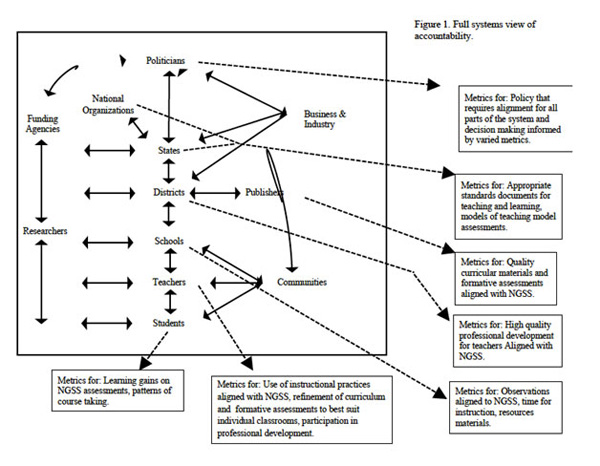
Supporting the Implementation of NGSS through Research: Accountability

Sherry A. Southerland, Florida State University
John Settlage, University of Connecticut
Nancy Brickhouse, University of Delaware
Little change will be effective unless there is a better understanding of the complexity of schools and the education process (Cromwell & Scileppi, 1995).
Decades of research into student learning have prompted science educators to discard the notion that science learning occurs by transmitting information from teacher to student. Instead, we recognize that students arrive at school with important ideas and experiences (Falk & Dierking, 2010), that they require guidance with engaging in the concepts and practices of science, and that directing students to monitor their thinking vastly increases their ability to learn (Abell & Lederman, 2007; Duschl, Schwingruber, & Shouse, 2007). We argue that perceptions of educational accountability have not matured at the same pace. Indeed, we argue that flawed conceptions of accountability have been responsible, in part, for fundamentally derailing previous educational reform efforts (Cohen & Moffitt, 2009). Consequently, if the Next Generation Science Standards (NGSS) are to improve the ways science is taught and learned and if we are to get the reform "right" this time, we must employ a more theoretically and empirically informed conceptualizations of educational accountability. With this goal in mind, we examine a recent attempt to change the educational system to highlight the dangers of an overly simplistic approach to accountability.
The expressed goal of No Child Left Behind Act (NCLB, 2001) was to reduce educational disparities. NCLB prompted each state to develop academic standards that identified the knowledge students were expected to learn. Schools were then held accountable for insuring that their students, and demographic subgroups (by family income, ethnicity, etc.), met identified academic targets. Initially, NCLB's lever for change relied on student test scores in mathematics and reading (science was added in later years) as the metrics for success. The potential for rewards and the fear of punishment were expected to apply the pressure to propel schools to attain proficiency targets. More than stable goals, the proportion of students reaching ever-increasing performance targets represented "progress." In NCLB, a narrow array of measures (i.e., test scores in math and reading) drove accountability. Schools that met their targets received accolades and funding. Those that did not make adequate progress suffered a range of consequences that varied from state to state — from reductions in funding to the dismissal of all instructional and administrative staff (Supovitz, 2009). This reform attempted to drive accountability down to individual classrooms where teachers, and teacher education programs that produce them, were to be held accountable for student test performance.
The impact of NCLB on science education reveals the perils of restrictive accountability. In response to NCLB, schools shifted emphasis away from science as well as any efforts not directly included in annual accountability calculations for reading and math (Hartry et al., 2012). Classroom time, professional development, and instructional materials emphasized reading and mathematics because those were tested areas (Horizon, 2013). Especially in settings that struggled to produce strong test scores, resources were shifted with science often becoming a casualty (Lee et al., 2008). When fear of math and reading test performance loomed, many schools reduced or even eliminated time for science instruction (Saka et al., 2009). Did NCLB deliberately eradicate science from America's schools? In some respects, the answer does not matter since the effects are quite clear. Whether the intent or not, NCLB's accountability approach further exacerbated educational inequities in science simply by discouraging struggling schools from spending time on science while allowing successful schools the latitude to teach science (as well social studies, the arts, and so on). Further discussions about these issues can be found in Anderson (2012), Brickhouse (2013), and Southerland (2013).
NCLB produced clear changes to public education especially in terms of bringing accountability to bear on what teacher, administrators and superintendents think about and do on a daily basis. Unfortunately, the beneficial effects of NCLB are difficult to disentangle from the problems it created. While the authors of NCLB were wise to attach measures of performance to educational reform, the ways in which those measures were defined has further exacerbated educational inequities. How did this happen? Because of the failure to recognize that schools are embedded within broader, interconnected civic and educational systems, policymakers misjudged how school and educators would respond to NCLB legislation. If NCLB had been more attentive to how systems function, then the changes created by this legislation could have led to improvements rather than worsened educational opportunities. Because of its narrowly restricted accountability, NCLB increased educational inequity in science for many children by allowing science to be displaced by the narrow curricular focus on math and reading. Particularly for metropolitan and high-poverty schools systems, in the wake of NCLB children often receive NO science instruction. Worse yet, there is no evidence that this is a fair exchange; despite the intense focus on reading and mathematics scores, gains in these core areas never materialized and the achievement gaps remained (Dee & Jacobs, 2010; Lee, 2006). Science lost out, but it's also not clear whether expected benefits counter-balanced the situation.
Our stance is that a systems view of education would have allowed educators, policymakers and the public to anticipate the disastrous results of NCLB's approach to accountability. More specifically, the damage inflicted to science education was predictable given NCLB's narrow accountability criteria. Such missteps can be avoided during the adoption of the NGSS if we understand that education operates as a system that includes multiple relationships across many levels of that system (children, teachers, schools, districts, community sources of STEM education, families, etc.) (see Figure 1). It is our argument that a systems view of education and accountability can steer the implementation of the Next Generation Science Standards initiative to avoid past pitfalls and realize equitable and genuine improvements in schools.
Re-Defining Accountability Using a Systems Perspective
Even as NCLB fades, many citizens, politicians and policymakers maintain that the way to reform schools is by rewarding them for achievement and punishing them for failure. This presents an inaccurate portrayal because it is divorced from the reality of people and organizations. Furthermore, as NCLB has aptly demonstrated, such an approach fails to produce its intended effects. However, because of how it is drives change in education, accountability must be reconceptualized. Our understanding of accountability must be built using our knowledge that learners, teachers and schools are interconnected and mutually dependent components of the larger educational system (Figure 1). Within this view of organizations (Senge, 2001), change in a system requires that each component of the system is accountable for its role in that change. As the NGSS are implemented, its success rests on acknowledging the mutual responsibilities inherent among components of the larger educational system.
Because no component of the system is independent from the others, science education reform requires that each level accepts responsibility for their contribution to success. In this way, accountability must be infused through all levels of the system and not restricted to the lower levels (i.e., schools, teachers, students). This is a radical departure from the accountability approach within NCLB or even the stance taken by the Council of Chief State School Officers (2011). This re-definition of educational accountability demands that we apply metrics to determine the extent to which each system level contributes to the greater whole (see figure 1).

Yes, students should demonstrate their learning on standardized measures in science, because that is what the current climate accepts as valid. NCLB demonstrated that what is not tested is not taught. However, it is essential that all levels of the system must be held accountable which is accompanied by the need to develop accountability metrics for each system component. For example, teachers need to demonstrate their use of effective instructional practices in science. The metric for schools would include allocating appropriate classroom time for science, as well as providing planning time for teachers to coordinate science instruction. A school district's metric should address providing strong professional development to support learning of teachers and administrators. The metrics for success for states must include providing the resources needed to implement the NGSS — including assessments that adequately measure the science knowledge and skills targeted by the NGSS. Publishing houses should be held accountable for the extent to which their instructional materials and assessments align with the NGSS. Full acknowledgement needs to be given to the fact that learning outside of school can and does significantly influence student achievement (Alexander, Entwisle,& Olson, 2007). Finally, all parts of the system should align their efforts to complement and support each other's strengths and weaknesses. In short, for the NGSS to be successful, we must recognize that it has not been productive to exclusively focus accountability at the lowest level of the systems (students and teachers). Rather, each component of the educational system must be accountable to contributing to the greater whole with each being recognized for the unique contribution it provides.
Accountability Must Include a Focus on Alignment among System Elements
Using data to inform educational decision-making and tying those decisions to economic resources act as powerful levers affecting rapid change in schools. Carefully aligned assessments are necessary to ensure that the data generated will inform the intended changes. We must remember that students' success on assessments is only valuable to the degree those assessments align with the agreed upon goals of the entire system. As described by the NSTA (2013) and suggested by the CCSSO (2011), improvements to science education require coordinating and aligning actions across all levels of the system toward a commonly agreed upon goal. If the reforms intended by the NGSS are to succeed, each element of the system (and not just the formal school system) must seek to maintain that alignment. Figure 1 identifies some metrics that we offer for consideration, but others need to be developed.
Such alignment can only be possible with tangible portrayals of science teaching and learning for the system players to focus upon. A limitation of NCLB legislation was the absence of clear instructional expectations: end goals were identified, sanctions were specified, but legislation was evasive about ways in which to achieve these goals. This silence was an intentional acknowledgement of states' rights. Because of the silence about desirable teaching approaches the system responded in ways that were often superficial (e.g., emphasis on test preparation). Hitching the non-systems view to standardized test results absent guidance about desired teaching approaches actually exacerbated problems NCLB was designed to resolve. A fundamental improvement to science education in this country requires well-crafted standards as exemplified by NGSS. But as suggested by Darling-Hammond (2012), the NGSS standards must be supplemented by descriptions of teaching practices that support students' construction of targeted knowledge and skills, in full recognition that these practices must be sensitive to students varied and unique needs. In the absence of such descriptions, research and development efforts are seriously needed. Furthermore, schools and districts must be held accountable for providing teachers with the material and intellectual resources needed to improve their science teaching practices. Setting new benchmarks will be of little value if we do not also address how we can help teachers improve their practices to the benefit of science learning.
As NCLB aptly demonstrates, the pragmatic lever of educational change resides not in the content standards, but in the ways in which learning is assessed. It is not enough to simply designate expected student outcomes. At the level of the school, the information contained within the standards is far surpassed by the meanings teachers and administrators glean from assessments. There is clear evidence that teachers tend to examine the assessments in much greater depth than the content standard documents (Aydeniz & Southerland, 2012). For the NGSS to have positive impacts, assessments must serve as appropriate proxies for the desired science content and practices: the system quickly aligns itself with the assessments rather than the standards. Given the very different portrait of what it means to know science, the design of such assessments will be difficult and will require far more resources than are typically allocated to such tasks. To design assessments that serve as adequate proxies for science proficiency, a different, more collaborative approach involving groups of states may be useful in limiting costs and maximizing expertise. With movement toward implementing the NGSS, the metric for each level of the system must be closely aligned with the goals of the system. The success of the NGSS will require assessments and metrics for success for each level of the system that are true to the vision and specific intent of the standards.
The failure of NCLB speaks to the need to better understand the influence of educational policy on science teaching and learning. As a component of the larger educational system, educational researchers must become more responsible for understanding how educational policies influence what happens in classrooms, particularly for students traditionally underserved by our current system. As we have seen, lower performing schools are especially influenced by the changes in policy, and it is essential to systematically document those changes if we are to help the system become more effective for all learners.
Closing Comments
The success of NGSS is closely connected to the alignments of vision, responsibilities and goals across all levels of the system along with adopting a systems view of accountability. A systems view recognizes relationships across levels within the broader education system. Responsibilities between individuals, groups and levels should guide collective efforts and inform evidence-based decisions. A systems view of accountability depends on reciprocity and shared commitments; true education reform is not achievable with a narrow outcomes-based focus. If the NGSS are implemented with a simplistic view of accountability (rewards and punishments focused on teachers and students invoked without a clear alignment of the system around that goal) then once again, this reform will result in unintended and counterproductive consequences for students. Given the legacy of NCLB, these negative consequences will likely be much more severe for students already underserved in science classrooms. We must recognize that the exciting and compelling possibilities for student science learning represented by the NGSS can be realized — but only if implementation is accompanied by a systems perspective about educational accountability.
References
Abell, S.K., & Lederman, N.G. (2007). Handbook of research in science education. Mahwah, NJ: Lawrence Erlbaum Associates.
Alexander, K.L., Entwisle, D.R., & Olson, L.S. (2007). Lasting consequences of the summer learning gap. American Sociological Review, 72, 167-180.
Aydeniz, M., & Southerland, S.A. (2012). A national survey of middle and high school science teachers' responses to standardized testing: Is science being devalued in schools? Journal of Science Teacher Education, 23(3), 233-257.
American Association for Advancement of Science (AAAS). (1989). Science for all Americans. Washington: Author.
Anderson, K. (2012). Science education and test-based accountability: Reviewing their relationship and exploring implications for future policy. Science Education, 96(1), 104-129.
Brickhouse, N. (2013). Conceptions of inequality in the era of Bush/Obama. In J. Bianchini, V. Akerson, A. Calabrese Barton, O. Lee, & A. Rodriguez (Eds.), Moving the equity agenda forward (pp. 39-51). Netherlands: Springer.
Cohen, D., & Moffitt, S. (2009). The ordeal of equality: Did federal regulation fix the schools? Cambridge, MA: Harvard University Press.
Council of Chief State School Officers. (2011). Roadmap for next-generation accountability systems. Council of Chief State School Officers http://www.ccsso.org/Resources/Publications/Roadmap_for_Next-Generation_State_Accountability_Principles.html
Cromwell, R.R., & Scileppi, J. (1995). A systems approach to education. Retrieved from http://www.eric.ed.gov/ERICWebPortal/contentdelivery/servlet/ERICServlet?accno=ED392151
Darling-Hammond, L. (2012). Creating a comprehensive system for evaluating and supporting effective teaching. Stanford, CA: Stanford Center for Opportunity Policy in Education.
Dee, T., & Jacobs, B.A. (2010). Evaluating NCLB. Education Next, 10(3).
Duschl, R., Schweingruber, H. A., & Shouse, A. W. (2007). Taking science to school: Learning and teaching science in grades K-8. Washington, DC: National Academy Press.
Falk, J.H., & Dierking, L.D. (2010). The 95 percent solution. American Scientist, 98, 486-493.
Hartry, A., Dorph, R., Shields, P., Tiffany-Morales, J., & Romero, V. (2012). Untapped potential: The status of middle school science education in California. Sacramento, CA: WestEd.
Horizon Research. (2013). Report of the 2012 National Survey of Science and Mathematics Education. Retrieved from http://www.horizon-research.com/2012nssme/research-products/reports/technical-report/
Lee, J. (2006). Tracking achievement gaps and assessing the impact of NCLB on the gaps: An in-depth look into national and state reading and math outcome trends. Cambridge, MA: The Civil Rights Project at Harvard University.
Lee, O., Lewis, S., Adamson, K., Maerten-Rivera, J., & Secada, W. G. (2008). Urban elementary school teachers' knowledge and practices in teaching science to English language learners. Science Education, 92, 733-758.
National Research Council. (1996). National Science Education Standards. Washington DC: National Academy Press.
No Child Left Behind Act of 2001, Pub. L. No. 107-110, 115 Stat. 1425 (2002). Retrieved from http://www.ed.gov/legislation/ESEA02/
NSTA. (2013). NSTA position statement: Accountability. Retrieved from http://www.nsta.org/about/positions/accountability.aspx
Saka, Y., Southerland, S. A., & Brooks, J. (2009). Becoming a member of a school community while working toward science education reform: Teacher induction through a CHAT perspective. Science Education, 93, 996-1025.
Senge, P. (2001). Schools that learn. New York: Doubleday.
Southerland, S.A. (2013). The possibilities of teaching "Science for All" given national education policy: How policy influences the equitable teaching of science. In J. Bianchini, V. Akerson, A. Calabrese Barton, O. Lee,& A. Rodriguez (Eds.), Moving the equity agenda forward (pp. 21-37).Netherlands: Springer.
Supovitz, J. (2009). Can high stakes testing leverage educational improvement? Prospects from the last decade of teaching and accountability reform. Journal of Educational Change, 10, 211-227.
Suggested Citation
Southerland, S., A., Settlage, J., & Brickhouse, N. (2014). Supporting the implementation of the Next Generation Science Standards (NGSS) through research: Accountability. Retrieved from https://www.narst.org/
